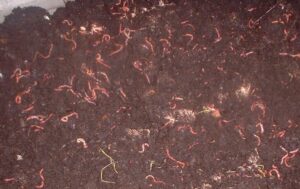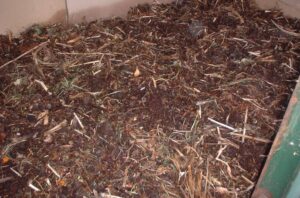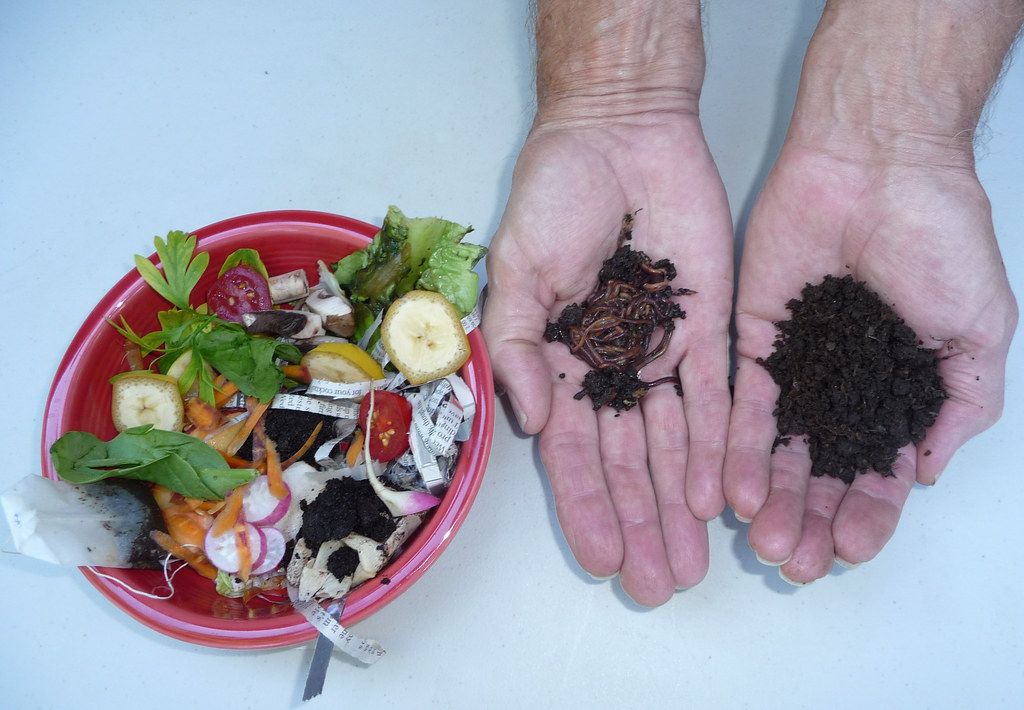What is Vermicompost and how to make Vermicomposting
As a farmer’s friend, we have been learning since childhood about Earthworms and useful information about manure. some people cultivate a hobby of making compost while others learn about this fertilizer to increase the fertility of their land, today I am going to give you information about such Vermicomposting. It takes time for us to do our best to maintain the fertility of the soil. Currently we see that the soil fertility or its level has gone down by chemical treatment, we have learned about many technologies to make compost from wet waste, Earthworm manure is also a technology that we convert wet waste into compost, we use Earthworm to convert wet waste into compost. Uses. We say that Earthworm are the friend of the farmers as they help the farmers to increase their yield by increasing the fertility of the soil by producing proper fertilizer from the waste. at present, the government or the government forces the farmers to grow crops using chemical elements to relieve them, but as a result, the soil becomes accustomed to the chemical elements and the land becomes barren and it becomes very difficult to grow crops and this has adverse effects on the environment. The fertility of the soil is declining day by day. As a result, the cost of production has gone up drastically and as we see farmers going into debt, it is very important to increase the fertility of the land. You can increase soil fertility by using Vermicompost.
What is Vermi?
Before we learn more about earthworm manure, let us first know what earthworm is. An Earthworm is an animal that lives in the soil and consumes organic matter. This process takes at least a couple of days, and he keeps only ten percent for his own body and removes the remaining ninety percent. Vermicompost is an important component of organic farming which boosts the immunity of your plants. We use Vermicompost as a granular organic fertilizer containing nutrients, hormones.
Types of Earthworms:
 Epigeic : These earthworms live near the surface of the soil. Eighty percent of your food consumes organic matter, while 20 percent consumes soil and other nutrients. Their fertility rate is higher. They are small in size.
Epigeic : These earthworms live near the surface of the soil. Eighty percent of your food consumes organic matter, while 20 percent consumes soil and other nutrients. Their fertility rate is higher. They are small in size.
Anecic : These earthworms usually live up to a depth of one meter in the soil and eat organic matter and soil. They are medium in size.
Endogeic: These earthworms live up to a depth of three meters or more in the soil. They are long in size, pale in color and have a very low fertility rate. They mostly eat soil.
Due to the characteristics of these three species, Epigeic and Anecic earthworms are used for composting. The four most useful species are Isenia fetida, Perionics, Eudrilus and Lampito. They eat as much food every day as their own weight.
Suitable species of earthworm for vermicomposting:
Although there are more than 300 species of earthworms, the most important and suitable species of earthworms are mainly Isina foitida, Eudrilus eugenia, Perinoxy, Exovatus, Ferritima elongata. The growth of this variety is good and the process of making the manure takes 40 to 45 days.
Earthworm life cycle:
There are three stages in the life of an earthworm: egg, infancy and adulthood. All of these conditions require moist soil. The life cycle of earthworm depends mainly on its species. Full-grown earthworms have both female and male reproductive organs. The earthworm lays eggs every six to seven days. These eggs contain two to twenty embryos. Egg stage is 7 to 20 days depending on the weather conditions. Worm infestation lasts for two to three months. Then when it comes to maturity, 2 to 3 cm from the mouth. Half a cm apart. The shaped part becomes thicker. This is a sign of aged earthworms. The life span of earthworms is generally two to three years. Full grown earthworms of the genus Isinia fetida are 12 to 15 cm in length. Is. One kilogram normally holds one thousand full grown earthworms. If one thousand such earthworms are taken and reared in a favorable environment, their number in a year is eight lakh and thirteen thousand. Piglets and adult earthworms weigh 2,000 per kg. One hundred kilos of adult earthworms produce one ton of vermicompost per month.
Earthworm conservation and vermicompost production
Site selection and construction
The soil should be well drained when selecting a vermicomposting site. Also, there should not be large trees near the pit, as the roots of these trees absorb the nutrients in the vermicompost. Since shade is required for making vermicompost, the roof should be prepared as follows. When making it, the width should be 5 and a half meters, height in the middle 3 meters, side height 1 meter and length should be 5 to 25 meters as per the requirement – depending on the available manure and the material required for the roof. The roof is 1 m wide and 20 cm wide. Dig two parallel variables of the depth.
Worm food
8 to 9 cm at the bottom of the pasture. Height or thick layer should be filled with kadikachara, mulch, dried grass, sugarcane husk. Sprinkle water on it. 8 to 9 cm. Apply second layer of composted manure, land manure, organic manure. Sprinkle water on it till it gets wet, then release earthworms on this layer. 5 to 6 cm. Apply a thick layer of decomposed organic manure and cow dung. 20 to 30 cm on this layer. Apply manure, land manure, organic manure till height. Sprinkle water on it till it gets wet. This mattress should be covered with gonapat. Sprinkle water on this mattress every day so that the mattress stays moist and vermicompost grows well. In this method vermicompost is prepared in 15 to 20 days. Similarly, household waste, sewage and kitchen waste can also be used.
Also Read: What is Aerobic Composting? how to Start Composting?
The growth of earthworms is best in manure. Their numbers increase exponentially to produce better quality vermicompost. In the same way, earthworm manure is also made from horse manure. The food required for earthworms should be at least partially decomposed. Vermicompost can be made using a mixture of manure and organic manure in half. Earthworms can use wet leaves from the field, vegetable residues, partially decomposed crop residues, press mills from sugar mills. However, when using this food for earthworms, it is necessary to add some amount (one third) of manure. Always grind vermicompost. Slurry from biogas plants can also be used as vermicompost. Before putting earthworms in the pit, apply water on the earthworm feed for four to five days to remove the heat. Fertilizer decomposition should be done using bacterial culture. In addition, when one kg of urea and one kg of superphosphate per ton is mixed in the vermicompost, the decomposition process will be faster and the vermicompost will be ready sooner. The number of earthworms increases by 10 times if the leaves of Glycerdia are placed on the earthworm bed and a 4 inch thick layer of dung is applied on it.
Methods of vermicomposting:
Vermicompost can be prepared by both mound and pit methods. However, both methods require artificial shade. Roof sheds should be constructed to protect them from sunlight and rain. The length of this shed should be 4.25 m for two mounds and 7.50 m for four mounds. The shelter should be sloping on both sides of the shed. The height of side pillars should be 1.25 to 1.50 m and the height of middle pillars should be 2.25 to 2.50 m. Use grass, paddy straw, coconut husks, cotton or turmeric sticks, sorghum trays, thick plastic paper or cement or iron sheets for roofing. Choose the right variety of earthworm to make vermicompost.
Heap method:
 Approximately 2.5 to 3.0 m. Length and 90 cm. Make piles of width. First the soil should be watered and moistened. At the bottom of the mound 3 to 5 cm of non-perishable substances like coconut husk, grass, rice husk etc. I Form a thick layer, sprinkle enough water on it and make it wet. 3 to 5 sec on this layer. I Apply a layer of semi-decomposed dung, compost or sifted garden soil. Full grown earthworms should be gently released on this layer. Normally 100 kg. 7,000 adult earthworms should be released to make vermicompost from grams of organic matter. On the second layer, crop residues, animal manure, grain bran, field weeds, leaves of dicotyledonous green trees like Giripushpa Shevari, manure manure, hen droppings etc. should be used. It is better to use these organic substances in small pieces and in partially decomposed form. The carbon : nitrogen ratio should be between 30 and 40. Care should be taken that the height of the entire mound does not exceed 60. Rotting organic matter should contain 40 to 50% water. For this, cover the mound with gonapat and spray water daily. Care should be taken to keep the temperature of the organic matter in the heap between 25 and 30 degrees Celsius.
Approximately 2.5 to 3.0 m. Length and 90 cm. Make piles of width. First the soil should be watered and moistened. At the bottom of the mound 3 to 5 cm of non-perishable substances like coconut husk, grass, rice husk etc. I Form a thick layer, sprinkle enough water on it and make it wet. 3 to 5 sec on this layer. I Apply a layer of semi-decomposed dung, compost or sifted garden soil. Full grown earthworms should be gently released on this layer. Normally 100 kg. 7,000 adult earthworms should be released to make vermicompost from grams of organic matter. On the second layer, crop residues, animal manure, grain bran, field weeds, leaves of dicotyledonous green trees like Giripushpa Shevari, manure manure, hen droppings etc. should be used. It is better to use these organic substances in small pieces and in partially decomposed form. The carbon : nitrogen ratio should be between 30 and 40. Care should be taken that the height of the entire mound does not exceed 60. Rotting organic matter should contain 40 to 50% water. For this, cover the mound with gonapat and spray water daily. Care should be taken to keep the temperature of the organic matter in the heap between 25 and 30 degrees Celsius.
Pit method:
 In this method cement pits are 3 m long, 2 m wide and 60 cm deep. I Should be kept. At the bottom of the pits, coconut husk, grass, rice bran, wheat bran 3 to 5 cm. I Apply a layer of partially decomposed dung, compost or sifted soil in the garden. Wet both the layers completely with water and apply about 100 kg. Solve 7,000 adult earthworms to make vermicompost from gram organic matter. A maximum of 50 cm of semi-decomposed organic matter is placed on it. Form a thick layer. Always keep it wet by covering it with gonapat. For the growth of earthworms, air must be circulated in the organic matter in the pit. For this, if the layer of organic matter thickens, loosen it by hand. So the temperature in the pit will be controlled. The cone shape of the vermicompost made in this way should be piled up. Separate the manure from the top of the mound and dry it in the shade. Worms separated after sieving, they should use the chicks and testicles to make vermicompost again.
In this method cement pits are 3 m long, 2 m wide and 60 cm deep. I Should be kept. At the bottom of the pits, coconut husk, grass, rice bran, wheat bran 3 to 5 cm. I Apply a layer of partially decomposed dung, compost or sifted soil in the garden. Wet both the layers completely with water and apply about 100 kg. Solve 7,000 adult earthworms to make vermicompost from gram organic matter. A maximum of 50 cm of semi-decomposed organic matter is placed on it. Form a thick layer. Always keep it wet by covering it with gonapat. For the growth of earthworms, air must be circulated in the organic matter in the pit. For this, if the layer of organic matter thickens, loosen it by hand. So the temperature in the pit will be controlled. The cone shape of the vermicompost made in this way should be piled up. Separate the manure from the top of the mound and dry it in the shade. Worms separated after sieving, they should use the chicks and testicles to make vermicompost again.Fertilizer preparation period
It usually takes 35 to 50 days to make vermicompost using earthworms.
Important matters for making vermicompost
The vermicompost project should be in a shady and humid ventilated place.Manure and field crop residues and plant leaves should be in the ratio of 3: 1 and all these should be decomposed for 15-20 days before release of earthworms. at the bottom of the pit, first add 15 to 20 cm of finely chopped dried leaves.Water the Earthworms for 1 day before releasing the Earthworms. Water the earthworms daily or depending on the temperature of the atmosphere. There should be a special net for the vermicompost to collect the vermiwash, plan to collect the vermiwash by digging a hole there
Isolation of Vermicompost
Assume that the manure is formed when the color of the manure turns dark brown. Watering should be stopped when manure is ready. When the top layer is a little dry, remove the whole vermicompost from the bed. Should take. In 3-4 hours, all the earthworms should be left in the bed / pit for composting. In the same way, vermicompost can be prepared by pit, pot or tank method. In addition to this, as a second method, lightly collect the Vermicompost layer prepared on the mattress and add new food on the mattress. This vermicompost consists of a mixture of earthworm eggs, their droppings and decomposed manure. Such earthworm manure can be used in the field. Apply this fertilizer at the rate of 5 tons per hectare per year for different crops. With prepared manure-worms
Benefits of Vermicomposting:
- Improves soil texture.
- Appropriate changes are made in the composition of the soil particles.
- Worm weevils provide excellent cultivation without damaging the roots of the plant.
- Increases the water holding capacity of the soil.
- Soil erosion is reduced.
- Evaporation rate decreases.
- Soil level (pH) is maintained at proper level.
- The earthworms bring the soil from the lower layer to the surface and make it better.
- As Vermicompost is rich in humus, nitrogen, phosphorus, potassium and other micronutrients are abundant and readily available to plants.
- The number of useful bacteria in the soil increases exponentially.
- There was also wet waste management
- Soil fertility is maintained
- This fertilizer keeps the microorganisms in the soil alive.
- This fertilizer keeps the soil fertile.
Also Read: how to reduce food waste by other methodes.
Share this post to maximum people or tweet by clicking bellow link, if liked.

I гead thіs article fully concerning the comparison of most up-to-date and
preceding technologies, it’s awesome article.